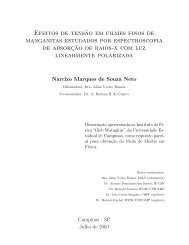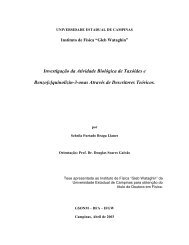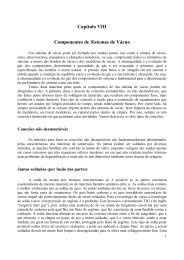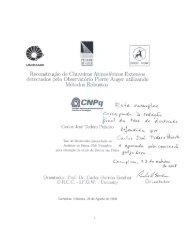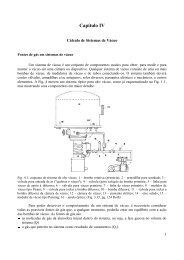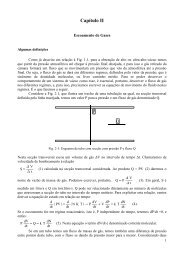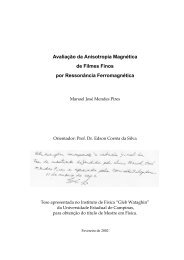Faça o download da tese completa na versão em PDF - A Biblioteca ...
Faça o download da tese completa na versão em PDF - A Biblioteca ...
Faça o download da tese completa na versão em PDF - A Biblioteca ...
You also want an ePaper? Increase the reach of your titles
YUMPU automatically turns print PDFs into web optimized ePapers that Google loves.
BRIEF REPORTS<br />
PHYSICAL REVIEW B 74, 193401 2006<br />
TABLE I. Statistics of LAC formation along different crystallographic<br />
orientations. In parentheses we indicated the number of<br />
LAC occurrences per total number of MD simulations, for the respective<br />
direction. MD simulations at 300 K and pulling velocities<br />
in the range 0.1–10.0 m/s.<br />
Crystal direction 111 110 100<br />
Statistics % 65 130/200 55 110/200 1 2/200<br />
FIG. 3. Color online S<strong>na</strong>pshots from MD simulations of Cu<br />
NW elongation along a 100, b 110, and c 111 crystallographic<br />
directions, pulling velocity at 1.0 m/s, and t<strong>em</strong>perature<br />
300 K see text for discussions.<br />
experimentally observed for gold NW’s. 34 Consistent with<br />
the HRTEM experimental <strong>da</strong>ta, we have observed LAC<br />
structures for all the crystallographic directions investigated.<br />
The number of atoms in the LAC is dependent, as expected,<br />
on the pulling velocity, t<strong>em</strong>perature, and initial velocity<br />
distributions. In the regime of t<strong>em</strong>peratures around<br />
300 K, as a general trend we have observed three distinct<br />
behaviors modulated by the adopted pulling velocity values:<br />
a 0.1 m/s, the syst<strong>em</strong> has enough time to relax and<br />
distribute the inter<strong>na</strong>l stress. Good structural order and faceting<br />
of the apexes is obtained but no LACs is observed. b<br />
1.0 m/s, now the inter<strong>na</strong>l stress is not perfectly distributed,<br />
defects start to appear like twins and the LAC formation<br />
is favored. c 10.0 m/s, at these values LAC’s are<br />
no longer observed and has a poor apex faceting, indicating<br />
that the syst<strong>em</strong> inter<strong>na</strong>l stress is not well distributed and a<br />
large number of defects occur.<br />
When MD simulations are carried out at low t<strong>em</strong>peratures<br />
30 K, independently of the pulling velocity and crystallographic<br />
orientation, we did not observe any LAC structure.<br />
It se<strong>em</strong>s that at this t<strong>em</strong>perature regime it is not easy to<br />
distribute the syst<strong>em</strong> inter<strong>na</strong>l stress even at medium and high<br />
pulling velocity and the formation of defects is favored. At<br />
the low-pulling-velocity regime the syst<strong>em</strong> behavior is similar<br />
to the high-t<strong>em</strong>perature 300 K case. This is consistent<br />
with previous works 16,17 and a vali<strong>da</strong>tion that our theoretical<br />
methodology is robust. Our MD simulation results strongly<br />
suggest that LAC formation is feasible only t<strong>em</strong>peratures<br />
above 200 K.<br />
Table I summarizes the statistics of LAC formation derived<br />
from the MD simulations at 300 K and 0.1–10.0 m/s<br />
pulling velocities. Although the formation of suspended<br />
chains was observed for all directions, it occurs predomi<strong>na</strong>ntly<br />
for 111 and 110 NW’s Figs. 2a and 2b. Although<br />
Cu, Au, and Ag share many common structural features,<br />
the NW’s exhibit clearly differentiated patterns<br />
regarding LAC occurrence. 1,18 Experimentally and theoretically,<br />
it has been observed that Au chains are generated with<br />
decreasing occurrence rate for 111, 100, and 110<br />
axes, 5,30 while Ag shows a completely different pattern<br />
100, 110, and 111, in decreasing order 19 . Our simulations<br />
indicate that Cu LAC’s show behavior which is distinct<br />
from Au and Ag 111, 110, and 100, in decreasing order.<br />
In summary, in this work we report results from HRTEM<br />
experiments and molecular dy<strong>na</strong>mics simulations for the mechanically<br />
stretching copper <strong>na</strong>nowires. In contrast with previous<br />
MCBJ experiments at low t<strong>em</strong>peratures 17 and ab initio<br />
calculations, 16 we have experimentally and theoretically observed<br />
LAC formation for all crystallographic orientations<br />
investigated.<br />
This work was supported by Brazilian agencies LNLS,<br />
CNPq, FAPESP, FAPEMIG, IMMP/MCT, IN/MCT, and<br />
CAPES. The authors acknowledge the invaluable help of the<br />
LNLS staff, in particular P.C. Silva for sample preparation.<br />
41<br />
193401-3



